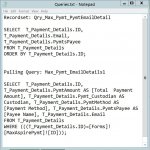Hi,
I have an issue when my code runs, it only grab the records that the cursor is on and not looping through to grab the specific records grouped by ID....For the 31 clients, ID 48961 which is 1 client of the 31 clients which the cursor was on in the Form was the only records pulled for the 31 different client groups...See Attachment Below...My issue is I'm only pulling records where my cursor is pointing to and not looping through all the records...Thanks
Private Sub cmdSendRpt_Click()
Dim rst As DAO.Recordset
Dim strSql As String
strSql = "Select * FROM Qry_Max_Pymt_PymtEmailDetail;"
Set rst = CurrentDb.OpenRecordset(strSql)
Do While Not rst.EOF
Me.txtID = rst![ID]
DoCmd.OutputTo acOutputQuery, "Max_Pymt_EmailDetails1", acFormatXLS, "C:\Users\amccoy\Desktop\TestFolder" & "\" & rst![ID] & "_" & rst![PymtsPayee] & ".xls"
DoEvents
rst.MoveNext
Loop
rst.Close
Set rst = Nothing
End Sub
I have an issue when my code runs, it only grab the records that the cursor is on and not looping through to grab the specific records grouped by ID....For the 31 clients, ID 48961 which is 1 client of the 31 clients which the cursor was on in the Form was the only records pulled for the 31 different client groups...See Attachment Below...My issue is I'm only pulling records where my cursor is pointing to and not looping through all the records...Thanks
Private Sub cmdSendRpt_Click()
Dim rst As DAO.Recordset
Dim strSql As String
strSql = "Select * FROM Qry_Max_Pymt_PymtEmailDetail;"
Set rst = CurrentDb.OpenRecordset(strSql)
Do While Not rst.EOF
Me.txtID = rst![ID]
DoCmd.OutputTo acOutputQuery, "Max_Pymt_EmailDetails1", acFormatXLS, "C:\Users\amccoy\Desktop\TestFolder" & "\" & rst![ID] & "_" & rst![PymtsPayee] & ".xls"
DoEvents
rst.MoveNext
Loop
rst.Close
Set rst = Nothing
End Sub






